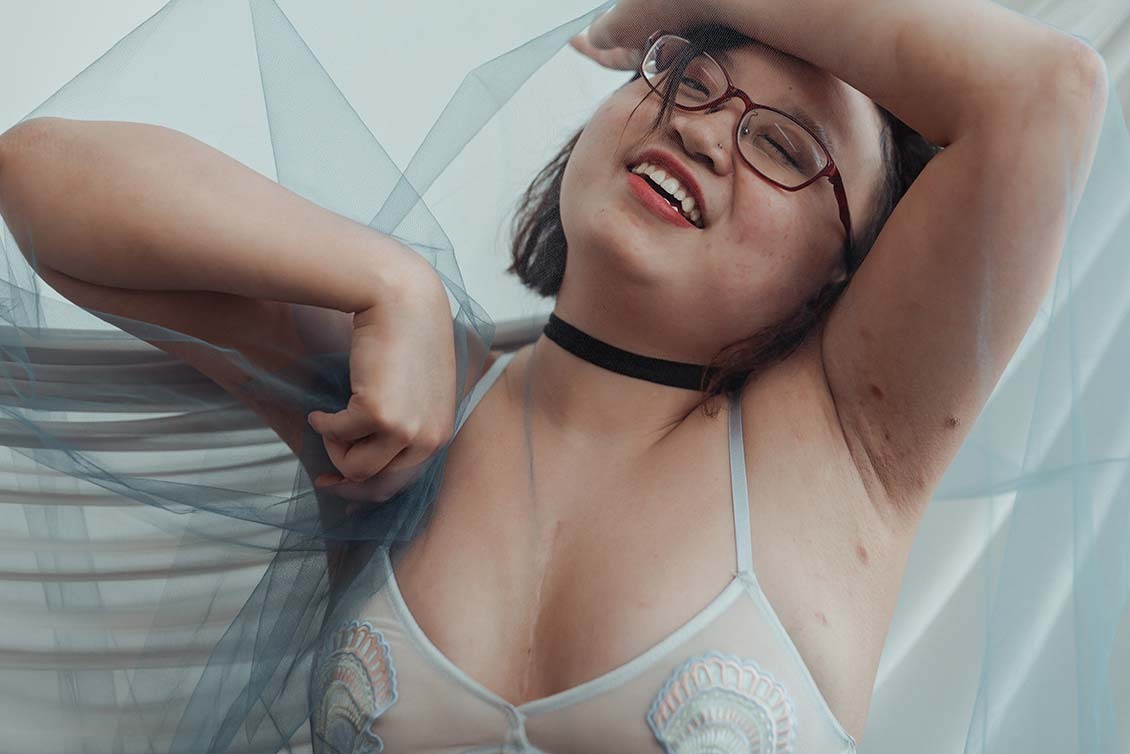Written by Jennifer Lee.
Art by Mariane Leon.
I squatted in my dad’s office, underneath his desk. I could hear his lawn mower purring through the open window. I slowly pulled my white t-shirt up, exposing my chest. I held it there for a moment. What he didn’t know couldn’t hurt him. I was playing “beach.” But here comes the kicker: 6-year-old Jenny, with her long dirty blond hair, pink sweaters, and floral dresses, decided she was a boy.
In one swift motion, I pulled the shirt up over my head and admired myself. I put my arms up in the air as if they were resting on the invisible shoulders of two cute girls. This was boyhood. The solitude, the sideways glances, the perked ears marked my first taste of a gender that was never my own. I knew it was wrong. I could hear the danger in every floorboard creak and A/C churn.
Suddenly, a door opened somewhere in the house. I froze. Panic-stricken enough to forget to put my shirt back on, I scrambled into bed, neck deep under the covers. When my dad walked into the room and asked why I was in bed at two in the afternoon, I knew it could’ve been the end of me right then and there. If he pulled down the covers, he would know I’d broken the gender rule: Girls aren’t supposed to be shirtless at the beach.
That was the first and only time I recall conflating my gender during my adolescence. In fact, I was always certain that my entire adolescence could be deduced to the bumblings of a closeted dyke boi, unpacking the suppression of being queer. But then, during quarantine, a new trend flooded queer social media: countless people were saying that when they’d come out as queer they thought that was it, but now they were questioning their gender, too.
And if you’re reading this, maybe you’re questioning the same thing.
One hot LA morning I looked in my floor-length mirror and saw the suburban Cali girls I grew up with—the short shorts and baby doll tee girls I painstakingly strived to fit in with. They looked back at me, giggling, and said, “You did it girl. You’re finally like us.” It was all I’d ever wanted, and yet I hated myself for it. Turns out I wasn’t the only one.
“I honestly wish I saw more androgynous people and gender nonconformity growing up,” said Natasha Segebre, a delightful human and photographer who is well versed in documenting her gender journey online. “It would’ve made my whole self-discovery a lot easier.” As a kid, the only normalized gender presentations I saw were heteronormative and reinforced a binary. It was only when I let myself hate the way I dressed that I was able to try my hand at presentations and identities that actually excited me.
Unpacking your gender starts with a question. Personally, I wondered why my style was so inconsistent. My regular style was simple and androgynous, but when I’d go out pre-COVID I dressed very feminine—lots of makeup, revealing shirts, and high heels. I was often told I looked like an entirely different person (Not going to lie, it made for a lot of awkward first dates.)
“It wasn’t so much a crystal-clear moment as it was a development of feelings over time,” said Segebre. “Ever since I was 4 or 5, I would sneak into my brother’s closet and wear his cargo shorts as if they were my dirty secret. I had such a natural aversion to anything feminine. You name it, I hated it.”
More likely than not, your question won’t be fully formed. By that, I mean it may present as a feeling of uncertainty. For me, it was constantly feeling apologetic about my appearance. I was never confident. If someone questioned why I wore a particular shirt or kind of makeup, I’d shut down. I knew deep down I was only wearing it because I’d seen someone else doing it.
“It’s really just about experimenting with how you express yourself,” said Segebre. “And not letting binaries make you feel like you have to stick to a certain set of things.” Without further ado, here are six steps I’ve prepared to help you pretty people experiment.
1. Go into your closet and donate/sell any clothes that you’re wearing for someone else.
Pick up each item and ask yourself—are you excited to put it on? After my mirror incident, I donated and sold 85% of my wardrobe. That shit was cathartic, like a break-up I’d been dragging out for a decade. Now I only have t-shirts, windbreakers, and jeans, and I love every piece of clothing I own.
2. Take a break from your beauty and personal care routine.
I don’t mean give up hygiene, but take a break from any superfluous makeup or shaving for a week or two. Once you’re comfortable with your natural self, determine what you’d like to bring back into your routine.
3. Pay attention to who you admire.
This was a big clue for me because almost everyone I admire is someone I’m attracted to or want to be like. When I saw myself following every she/they on TikTok, I knew that was a big ole sign. I’m trying out she/they pronouns, and so far the shoe fits.
4. Separate your gender from your sexuality.
I know a lot of individuals, myself included, who are very attached to their sexual identity. Being a lesbian and a dyke means more than just attraction. It’s a community. It’s a shared history spanning millennia. At the end of the day, I believe the most important thing in life is to find fulfillment alone. I can be happy being a lesbian amongst other queers, but as an individual I might want to embrace a gender identity that would contradict my public image. That’s okay! Once I find the gender identity that feels right to me, any community and partner I find will be frosting on the cake.
5. Understand that gender is more than just a construct.
Because I’m a contrarian (eye roll, I know), there’s always that thought in the back of my mind that whispers, “Gender is just a construct. Clothes aren’t real, they’re fabric our society has assigned value to. So why are you making a fuss about all this?” The back of my mind is an asshole, but it has a point.
I’ve only recently come to understand that even though an aspect of one’s identity might be a social construct, it doesn’t make one’s needs or desires to subscribe to said aspect any less valid. It’s theory versus practice. In theory I want to shave my head and ditch clothes all together, but I can’t face the world bald and nude. So in practice, I can find clothing and a hairstyle that make me feel the most like me.
6. Remember that you’re never too old or young to unpack and question.
I clearly had some unpacking to do as young as six, and for most of my life I’ve found no pleasure in getting dressed. The same way I found no pleasure in having sex with a man. It wasn’t the game itself, but the way I was playing it.
I always felt “unpretty.” Couple that with the fact that women are constantly told that their lack of beauty is their own fault, and you get a little girl who didn’t know how to like herself. “When I was forced to wear feminine things and it didn’t make me appear or feel more like a traditional woman, I hated myself for it,” said Segebre. So while feelings of discontent with one’s face or body might be a sign of gender dysphoria, many of us, myself included, have confused it with feeling ugly.
Unlike me, Segebre took action and identified as a trans man from ages 15 to 18. And she continues to adjust her identity according to what feels right to her. “Right now I identify as a queer woman,” she mused. “And I float between different feelings of how I identify.”
The game isn’t about fitting in, but truly finding what an expression of your innate being looks like. “Just be patient with yourself,” said Segebre. “Understanding yourself isn’t something you figure out in a day or a week, so don’t feel bad if it’s taking you longer than you think it should—take all the time you need.”
Where queerness starts and ends is undefinable. We’ll never know when we are truly ourselves, because we’re constantly growing, shifting, and changing. I hope that doesn’t scare you, because the best of us never stop. 😉
XO, Jenny (she/they)
About the Author
Jennifer Lynae Lee is a podcaster, screenwriter and ex-Mormon queer living in Los Angeles and trying to do the damn thing.
Twitter: @themormondyke
Follow on IG: @@themormonlesbian | Follow on Twitter: @

